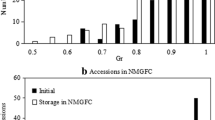Abstract
Seed collections in gene banks are useful for the preservation of wild germplasm, providing inexpensive insurance for species that survive in conventional cold storage (−18 °C). Seeds that cannot survive these conditions must be pretreated with cryoprotectants and stored at liquid nitrogen temperatures, which presents unique technical and methodological challenges. Implicit in this approach is the assumption that these added manipulations do not change the genetic diversity of the preserved collections. We used polymorphic microsatellite markers for an endangered aquatic grass, Texas wild rice (Zizania texana), to conduct a preliminary evaluation of the effects of cryogenic preservation of mature embryos on genetic diversity. Using several statistical approaches, we show that allele frequencies did not change in collections of seeds that underwent cryopreservation (cryoprotected) compared to those samples that was not exposed to cryopreservation (control). The retention of the allelic diversity at the five loci examined suggests that there were no significant changes in genetic diversity due to treatments and that these protocols may be appropriate for ex situ conservation of genetically diverse wild germplasm.
Similar content being viewed by others
References
Brown AHD, Hardner CM (2000) Sampling the gene pools of forest trees for ex situ conservation. In:Forest Conservation Genetics:Principles and Practice (eds. Young A, Boyle T, Boshier D), pp. 185–196. CSIRO, Melbourne, Australia.
Brown AHD, Marshall DR (1995) A basic sampling strategy: theory and practice. In:Collecting Plant Genetic Diversity; Technical Guidelines (eds. Guarino L, Ramantha Rao V, Reid R), pp. 75–91. CAB International Publishing, Wal-lingford, UK.
Crossa J, Vencovsky R (1999) Sample size and variance effective population size for genetic resources conservation. Plant Geneti. Resour. Newslett., 119, 15–25.
Dickie JB, Pritchard HW (2002) Systematic and evolutionary aspects of desiccation tolerance in seeds. In:Desiccation and Survival in Plants:Drying without Dying (eds. Black M, Pritchard HW), pp. 239–260. CAB International Publishing, Wallingford, UK.
Doyle JJ, Doyle JL (1987) A rapid DNA isolation procedure for small quantities of fresh leaf tissue. Phytochem. Bull., 19, 11–15.
Emery WHP, Guy MN (1979) Reproduction and embryo development in Texas wild rice (Zizania texana Hitchc.). Bull. Torrey Bot. Club, 106, 29–31.
FAO/IPGRI (1994) Genebank Standards. Food and Agricul-tural Organization of the United Nations/International Plant Genetic Resources Institute, Rome.
Goto K, Mugurama K, Kuramochi T, Shimozowa N, Hioki K, Itoh T, Ebukuro M (2002) Effects of cryopreservation of mouse embryos in vitro fertilization on genotypic frequencies in colonies. Mol. Rep. and Develop., 62, 307–311.
Goudet J (1995). FSTAT (vers. 1. 2):a computer program to calculate F-statistics. J. Hered., 86, 485–486.
Hearne CM, Ghosh S, Todd JA (1992) Microsatellites for linkage analysis of genetic traits. Trends Ecol. Evolut., 8, 288–294.
Lewis PO, Zaykin D (2001) Genetic Data Analysis:Computer program for the analysis of allelic data. Version 1. 0 (d16c). Free program distributed by the authors over the internet from http://lewis.eeb.uconn.edu/lewishome/software.html.
Linsmaier EM, Skoog F (1965) Organic growth factor require-ments of tobacco tissue cultures. Physiol. Plant., 18, 100–127.
Nei M (1987). Molecular Evolutionary Genetics. Columbia University Press, NY.
Pence VC (1995) Cryopreservation of recalcitrant seeds. In: Cryopreservation of plant germplasm I. Biotechnology in agriculture and Forestry (ed. Bajaj YPS), pp. 29–52. Springer, Berlin.
Petit RJ, El Mousadik A, Pons O (1998) Indentifying popula-tions for conservation on the basis of genetic markers. Conserv. Biol., 12, 844–855.
Power P (1997) Moisture, seeds and reproductive failure in Texas wildrice (Zizania texana ). The Southwestre. Natur., 42, 435–440.
Roberts EH (1972) Storage environment and the control of viability. In Viability of Seeds (ed. Roberts EH), pp. 253–306. </del>Chapman and Hall, London.
Sakai A, Kobayashi S, Oiyama I (1991) Survival by vitrification of nucellar cells of navel orange (Citrus sinensis var brasili-ensis Tanaka)cooled to )196 C. J. Plant Physiol., 137, 465–470.
Schoen DJ, Brown AHD (2001) The Conservation of wild plant species in seed banks. BioScience 51, 960–966.
Tajima A, Graham EF, Shoffner RN, Otis JS, Hawkins DM (1990) Cryopreservation of semen from unique lines of chicken germplasm. Poultry Sci., 69, 999–1002.
Thurston LM, Siggins K, Mileham AJ, Watson PF, Holt WV (2002a) Identification of amplified restriction fragment length polymorphism markers linked to genes controlling 858. boar sperm viability following cryopreservation. Biol. Reprod., 66, 545–554.
Thurston LM, Watson PF, Holt WV (2002b) Semen cryo-preservation:A genetic explanation for species and individual variation?. Cryo Lett., 23, 255–262.
Touchell DH, Walters C (2000) Recovery of embryos of Zizania palustris following exposure to liquid nitrogen. Cryo Lett., 21, 261–270.
Vertucci C, Farrant JM(1995) Acquisition and loss of desiccation tolerance. In:Seed Development and Germination (eds. Kigel J, Galili G), pp. 237–271. Marcel Dekker, New York, NY.
Walters C (2003) Principles for preserving germplasm in gene-banks. In:E. Guerrant, Strategies for survival (eds. Guerrant E, Havens K, Maunder M)Island Press Covelo, CA.
Walters C, Touchell DH, Power P, Wesley-Smith J, Antolin MF (2002) A cryopreservation protocol for embryos of the endangered species Zizania texana. Cryo Lett., 23, 291–298.
Wesley-Smith J, Pammenter NW, Berjak P, Walters C (2001) The effects of two drying rates on the desiccation tolerance of embryonic axes of recalcitrant jackfruit (Artocarpus hetero-phyllus Lamk.)seeds. Ann. Bot., 88, 653–664.
Author information
Authors and Affiliations
Rights and permissions
About this article
Cite this article
Richards, C.M., Reilley, A., Touchell, D. et al. Microsatellite primers for Texas wild rice (Zizania texana), and a preliminary test of the impact of cryogenic storage on allele frequency at these loci. Conservation Genetics 5, 853–859 (2004). https://doi.org/10.1007/s10592-004-1977-3
Issue Date:
DOI: https://doi.org/10.1007/s10592-004-1977-3




